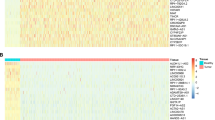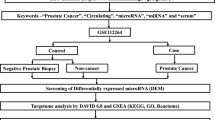Abstract
Pancreatic cancer is unresectable in over 80 % of patients owing to difficulty in early diagnosis. Chemotherapy is the most frequently adopted therapy for advanced pancreatic cancer. The development of drug resistance to gemcitabine (GEM), which is always used in standard chemotherapy, often results in therapeutic failure. However, the molecular mechanisms underlying the gemcitabine resistance remain unclear. Therefore, we sought to explore the microRNA-mRNA network that is associated with the development of gemcitabine resistance and to identify molecular targets for overcoming the gemcitabine resistance. By exposing SW1990 pancreatic cancer cells to long-term gemcitabine with increasing concentrations, we established a gemcitabine-resistant cell line (SW1990/GEM) with a high IC50 (the concentration needed for 50 % growth inhibition, 847.23 μM). The mRNA and microRNA expression profiles of SW1990 cells and SW1990/GEM cells were determined using RNA-seq analysis. By comparing the results in control SW1990 cells, 507 upregulated genes and 550 downregulated genes in SW1990/GEM cells were identified as differentially expressed genes correlated with gemcitabine sensitivity. Gene ontology (GO) analysis showed that the differentially expressed genes were related to diverse biological processes. The upregulated genes were mainly associated with drug response and apoptosis, and the downregulated genes were correlated with cell cycle progression and RNA splicing. Concurrently, the differentially expressed microRNAs, which are the important player in drug resistance development, were also examined in SW1990/GEM cells, and 56 differential microRNAs were identified. Additionally, the expression profiles of selected genes and microRNAs were confirmed by using Q-PCR assays. Furthermore, combining the differentially expressed microRNAs and mRNAs as well as the predicted targets for these microRNAs, a core microRNA-mRNA regulatory network was constructed, which included hub microRNAs, such as hsa-miR-643, hsa-miR-4644, hsa-miR-4650-5p, hsa-miR-4455, hsa-miR-1261, and hsa-miR-3676. The predicted targets of these hub microRNAs in the microRNA-mRNA network were also observed in the identified differential genes. As a result, a differential gene and microRNA expression pattern was constructed in gemcitabine-resistant pancreatic cancer cells. Therefore, these data may be useful for the detection and treatment of drug resistance in pancreatic cancer patients, and the microRNA-mRNA network-based analysis is expected to be more effective and provides deep insights into the molecular mechanism of drug resistance.




Similar content being viewed by others
References
Siegel R, Naishadham D, Jemal A. Cancer statistics, 2013. CA Cancer J Clin. 2013;63:11–30.
Warshaw AL, Fernandez-del CC. Pancreatic carcinoma. N Engl J Med. 1992;326:455–65.
Yeo CJ, Cameron JL, Sohn TA, Lillemoe KD, Pitt HA, Talamini MA, et al. Six hundred fifty consecutive pancreaticoduodenectomies in the 1990s: pathology, complications, and outcomes. Ann Surg. 1997;226:248–57.
Ahmad NA, Lewis JD, Ginsberg GG, Haller DG, Morris JB, Williams NN, et al. Long term survival after pancreatic resection for pancreatic adenocarcinoma. Am J Gastroenterol. 2001;96:2609–15.
Stefanska B, Arciemiuk M, Bontemps-Gracz MM, Dzieduszycka M, Kupiec A, Martelli S, et al. Synthesis and biological evaluation of 2,7-Dihydro-3H-dibenzo[de, h]cinnoline-3,7-dione derivatives, a novel group of anticancer agents active on a multidrug resistant cell line. Bioorg Med Chem. 2003;11:561–72.
Garcia-Manteiga J, Molina-Arcas M, Casado FJ, Mazo A, Pastor-Anglada M. Nucleoside transporter profiles in human pancreatic cancer cells: role of hCNT1 in 2′,2′-difluorodeoxycytidine-induced cytotoxicity. Clin Cancer Res. 2003;9:5000–8.
Saif MW. Options for the treatment of gemcitabine-resistant advanced pancreatic cancer: are we there yet? JOP. 2010;11:288–9.
Duxbury MS, Ito H, Zinner MJ, Ashley SW, Whang EE. RNA interference targeting the M2 subunit of ribonucleotide reductase enhances pancreatic adenocarcinoma chemosensitivity to gemcitabine. Oncogene. 2004;23:1539–48.
Giovannetti E, Del TM, Mey V, Funel N, Nannizzi S, Ricci S, et al. Transcription analysis of human equilibrative nucleoside transporter-1 predicts survival in pancreas cancer patients treated with gemcitabine. Cancer Res. 2006;66:3928–35.
Duxbury MS, Ito H, Zinner MJ, Ashley SW, Whang EE. Focal adhesion kinase gene silencing promotes anoikis and suppresses metastasis of human pancreatic adenocarcinoma cells. Surgery. 2004;135:555–62.
Duxbury MS, Ito H, Zinner MJ, Ashley SW, Whang EE. SiRNA directed against c-Src enhances pancreatic adenocarcinoma cell gemcitabine chemosensitivity. J Am Coll Surg. 2004;198:953–9.
Liau SS, Ashley SW, Whang EE. Lentivirus-mediated RNA interference of HMGA1 promotes chemosensitivity to gemcitabine in pancreatic adenocarcinoma. J Gastrointest Surg. 2006;10:1254–62.
Mahon PC, Baril P, Bhakta V, Chelala C, Caulee K, Harada T, et al. S100A4 contributes to the suppression of BNIP3 expression, chemoresistance, and inhibition of apoptosis in pancreatic cancer. Cancer Res. 2007;67:6786–95.
Kim MP, Gallick GE. Gemcitabine resistance in pancreatic cancer: picking the key players. Clin Cancer Res. 2008;14:1284–5.
Zhao YP, Chen G, Feng B, Zhang TP, Ma EL, Wu YD. Microarray analysis of gene expression profile of multidrug resistance in pancreatic cancer. Chin Med J (Engl). 2007;120:1743–52.
Lee KH, Galloway JF, Park J, Dvoracek CM, Dallas M, Konstantopoulos K, et al. Quantitative molecular profiling of biomarkers for pancreatic cancer with functionalized quantum dots. Nanomedicine. 2012;8:1043–51.
Carrington JC, Ambros V. Role of microRNAs in plant and animal development. Science. 2003;301:336–8.
Ma J, Dong C, Ji C. MicroRNA and drug resistance. Cancer Gene Ther. 2010;17:523–31.
Paik WH, Kim HR, Park JK, Song BJ, Lee SH, Hwang JH. Chemosensitivity induced by down-regulation of microRNA-21 in gemcitabine-resistant pancreatic cancer cells by indole-3-carbinol. Anticancer Res. 2013;33:1473–81.
Mittal A, Chitkara D, Behrman SW, Mahato RI. Efficacy of gemcitabine conjugated and miRNA-205 complexed micelles for treatment of advanced pancreatic cancer. Biomaterials. 2014;35:7077–87.
Giovannetti E, Funel N, Peters GJ, Del CM, Erozenci LA, Vasile E, et al. MicroRNA-21 in pancreatic cancer: correlation with clinical outcome and pharmacologic aspects underlying its role in the modulation of gemcitabine activity. Cancer Res. 2010;70:4528–38.
Nagano H, Tomimaru Y, Eguchi H, Hama N, Wada H, Kawamoto K, et al. MicroRNA-29a induces resistance to gemcitabine through the Wnt/beta-catenin signaling pathway in pancreatic cancer cells. Int J Oncol. 2013;43:1066–72.
Li Y, VandenBoom TN, Kong D, Wang Z, Ali S, Philip PA, et al. Up-regulation of miR-200 and let-7 by natural agents leads to the reversal of epithelial-to-mesenchymal transition in gemcitabine-resistant pancreatic cancer cells. Cancer Res. 2009;69:6704–12.
Ohuchida K, Mizumoto K, Kayashima T, Fujita H, Moriyama T, Ohtsuka T, et al. MicroRNA expression as a predictive marker for gemcitabine response after surgical resection of pancreatic cancer. Ann Surg Oncol. 2011;18:2381–7.
Djuranovic S, Nahvi A, Green R. MiRNA-mediated gene silencing by translational repression followed by mRNA deadenylation and decay. Science. 2012;336:237–40.
Li Y, Xu J, Chen H, Bai J, Li S, Zhao Z, et al. Comprehensive analysis of the functional microRNA-mRNA regulatory network identifies miRNA signatures associated with glioma malignant progression. Nucleic Acids Res. 2013;41:e203.
Monzo M, Navarro A, Bandres E, Artells R, Moreno I, Gel B, et al. Overlapping expression of microRNAs in human embryonic colon and colorectal cancer. Cell Res. 2008;18:823–33.
Wettenhall JM, Smyth GK. LimmaGUI: a graphical user interface for linear modeling of microarray data. Bioinformatics. 2004;20:3705–6.
Benjamini Y, Drai D, Elmer G, Kafkafi N, Golani I. Controlling the false discovery rate in behavior genetics research. Behav Brain Res. 2001;125:279–84.
Ashburner M, Ball CA, Blake JA, Botstein D, Butler H, Cherry JM, et al. Gene ontology: tool for the unification of biology. The gene ontology consortium. Nat Genet. 2000;25:25–9.
Draghici S, Khatri P, Tarca AL, Amin K, Done A, Voichita C, et al. A systems biology approach for pathway level analysis. Genome Res. 2007;17:1537–45.
Kornmann M, Danenberg KD, Arber N, Beger HG, Danenberg PV, Korc M. Inhibition of cyclin D1 expression in human pancreatic cancer cells is associated with increased chemosensitivity and decreased expression of multiple chemoresistance genes. Cancer Res. 1999;59:3505–11.
Jimeno A, Hidalgo M. Molecular biomarkers: their increasing role in the diagnosis, characterization, and therapy guidance in pancreatic cancer. Mol Cancer Ther. 2006;5:787–96.
Brody JR, Witkiewicz AK, Yeo CJ. The past, present, and future of biomarkers: a need for molecular beacons for the clinical management of pancreatic cancer. Adv Surg. 2011;45:301–21.
Dong Y, Stephens C, Walpole C, Swedberg JE, Boyle GM, Parsons PG, et al. Paclitaxel resistance and multicellular spheroid formation are induced by kallikrein-related peptidase 4 in serous ovarian cancer cells in an ascites mimicking microenvironment. PLoS ONE. 2013;8:e57056.
Ho AS, Huang X, Cao H, Christman-Skieller C, Bennewith K, Le QT, et al. Circulating miR-210 as a novel hypoxia marker in pancreatic cancer. Transl Oncol. 2010;3:109–13.
Boren T, Xiong Y, Hakam A, Wenham R, Apte S, Chan G, et al. MicroRNAs and their target messenger RNAs associated with ovarian cancer response to chemotherapy. Gynecol Oncol. 2009;113:249–55.
Xia L, Zhang D, Du R, Pan Y, Zhao L, Sun S, et al. MiR-15b and miR-16 modulate multidrug resistance by targeting BCL2 in human gastric cancer cells. Int J Cancer. 2008;123:372–9.
Wang H, Zhu LJ, Yang YC, Wang ZX, Wang R. MiR-224 promotes the chemoresistance of human lung adenocarcinoma cells to cisplatin via regulating G(1)/S transition and apoptosis by targeting p21(WAF1/CIP1). Br J Cancer. 2014;111:339–54.
Hong L, Yang Z, Ma J, Fan D. Function of miRNA in controlling drug resistance of human cancers. Curr Drug Targets. 2013;14:1118–27.
Tang D, Kang R, Livesey KM, Zeh HR, Lotze MT. High mobility group box 1 (HMGB1) activates an autophagic response to oxidative stress. Antioxid Redox Signal. 2011;15:2185–95.
Kang CB, Feng L, Chia J, Yoon HS. Molecular characterization of FK-506 binding protein 38 and its potential regulatory role on the anti-apoptotic protein Bcl-2. Biochem Biophys Res Commun. 2005;337:30–8.
Shi C, Ma Y, Liu H, Zhang Y, Wang Z, Jia H. The non-receptor tyrosine kinase c-Src mediates the PDGF-induced association between Furin and pro-MT1-MMP in HPAC pancreatic cells. Mol Cell Biochem. 2012;362:65–70.
Zhang YT, Xu LH, Lu Q, Liu KP, Liu PY, Ji F, et al. VASP activation via the Galpha13/RhoA/PKA pathway mediates cucurbitacin-B-induced actin aggregation and cofilin-actin rod formation. PLoS ONE. 2014;9:e93547.
Acknowledgments
This study was supported by the National Science Fundation of China grant 81102685 (PI Yehua Shen).
Conflicts of interest
The authors have declared no conflicts of interest.
Author information
Authors and Affiliations
Corresponding author
Rights and permissions
About this article
Cite this article
Shen, Y., Pan, Y., Xu, L. et al. Identifying microRNA-mRNA regulatory network in gemcitabine-resistant cells derived from human pancreatic cancer cells. Tumor Biol. 36, 4525–4534 (2015). https://doi.org/10.1007/s13277-015-3097-8
Received:
Accepted:
Published:
Issue Date:
DOI: https://doi.org/10.1007/s13277-015-3097-8




